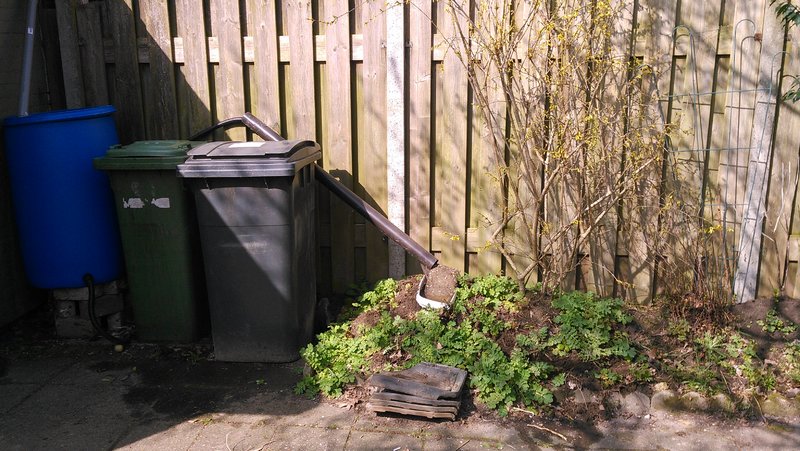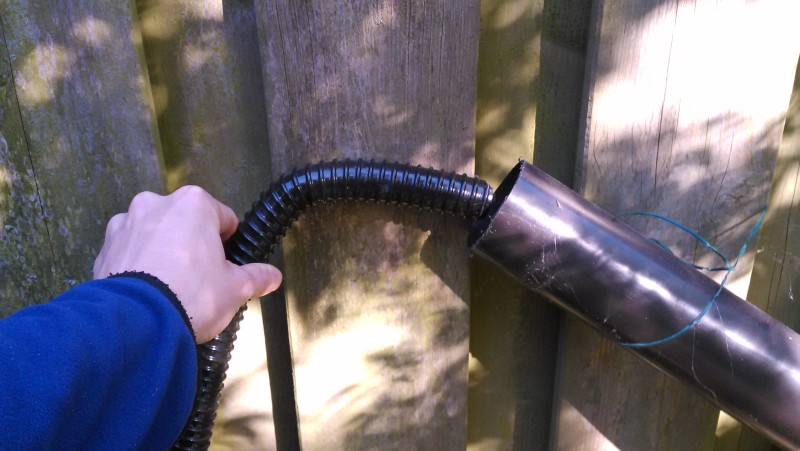Designing a water catchment for Arno's backyard (2018)
Posted on 2018-05-22 14:00 in designs • Written by Arno Peters
This is a design for the water catchment in Arno's backyard.

Water comes from the downspout via the grey pipe on the left. Water is stored in the blue barrel. Water overflows via the black tube and then down the brown pipe. The bucket makes for a small bird pool.
Background
Designer: Arno Peters.
Design strategy
I used CEAP in designing this.
Collect site information
See site information for all collected information on the backyard.
Evaluate the information
Two main sources of rain water catchment surfaces.
- downspout from shed
- downspout from neighbors extension and main roof area
Downspout from shed goes into draining area ground.
Downspout from house goes into sewer.
Location by the house is at a premium because of solar insolation.
Location by the shed is less suitable for growing plants due to north side of shed, mostly shaded area.
Apply Permaculture Principles
Holmgren principles
- Observe and Interact
- water from shed unused
- removing occasional blockage of downspout leads to flooding in the backyard
- shed is damp due to excess water in walls and floor
- Catch and Store Energy
- water catchment in rain barrel
- improve micro climate due to solar energy hitting rain barrel and heating water within
- Obtain a Yield
- water supply to water garden
- small water pool for birds, insects and aquatic animals
- clay added for gutter of overflow of pool can also be used by solitary bees and other insects in preparing for winter
- Apply Self-regulation and Accept Feedback
- first iteration was only temporarily storing water due to unexpected siphoning action of the hose when overflow was activated
- second iteration was reliably catching and storing water, barrel overflow was unused
- third iteration feeds overflow to water pool, and the overflow of the water pool to the plant border
- Use and Value Renewable Resources and Services
- catch available rain water from own and neighbor's shed
- overflow rainbarrel to feed water pool
- Produce No Waste
- purchase second hand 240 liter barrel
- reuse bricks to make a raised platform for the barrel
- reuse pipe
- reuse old paint bucket for water pool
- reuse concrete tile as safe landing area for insects
- reuse morcels of concrete waste to line gutter
- water is guided to locations where plants can directly use it
- Design from Patterns to Details
- store water closest to where it falls
- convert a flow into a stock, and back into a flow when needed
- gravity fed systems start high and next stages are at lower levels
- Integrate Rather than Segregate
- overflow and water outlet are the same
- water the garden using the rain water
- Use Small and Slow Solutions
- simple pipes
- use gravity
- Use and Value Diversity
- watering the garden can now be done by: rain directly, rain via storage, mains water
- Use Edges and Value the Marginal
- locate the barrel in the corner edge of the garden
- use plant border for water infiltration
- water trees at the drip line, thus lead overflow along drip line
- Creatively Use and Respond to Change
- first iteration used a sock for filtering that proved unnecessary
- first iteration caused the barrel to empty in full once the siphoning effect of the hose was activated, make sure the end of the hose is highest point (not somewhere in the beginning or the middle)
Plan for action
Implement
The barrel I bought had no detachable lid. I sawed off the top of the barrel and placed it upside down back on the barrel. In the side of the barrel, almost at the bottom I drilled a 2,5cm hole. I attached the hose connector to the barrel.
I created a base from bricks. I placed the barrel on top. I attached the hose to the hose connector at the bottom. I suspended the end of the hose. I added a pipe between the downspout of the shed and one of the holes in the top of the barrel.
Operation: as water fills the tank, it also fills the hose. The end of the hose is suspended below the top of the barrel. When the water reaches the end of the hose, it overflows. It does not overflow the barrel.
To water the garden: set the watering can on the ground. Take the end of the hose and put it over the opening of the watering can. The water starts flowing into the can. To stop the flow, raise the end of the hose up to higher than the top of the water barrel.
The pipe is 5cm diameter. The hose is 2,5cm diameter. A smaller diameter for the hose can lead to clogging. The hose can fill a 10 liter watering can in about 20 seconds.
First iteration

Second iteration

Close ups



Maintain
So far no maintenance has been necessary.
Evaluate
The water catchment works well. The barrel will fill almost to the rim before the system overflows. Getting the water out of the barrel is very easy using the overflow hose. It takes a bit of practice to minimize spilling when stopping the flow of water.